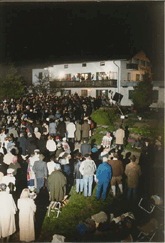

|
 |

The film team included over 70 people who took care of masks, hairdos, costumes, structures, lighting etc. As soon as it got dark, things got going. Everything had to be done by dawn. Some of the equipment suddenly failed. Then there were problems with the camera. Some spare parts had to be fetched from Munich ...
In spite of all the difficulties, everything was in the box shortly before sunrise. By 6 a.m. the space on which over 2,000 people had just been camping was swept empty. Nothing more remained of the events of the night.
|
 |